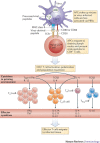Expanding roles for CD4⁺ T cells in immunity to viruses
- PMID: 22266691
- PMCID: PMC3764486
- DOI: 10.1038/nri3152
Expanding roles for CD4⁺ T cells in immunity to viruses
Abstract
Viral pathogens often induce strong effector CD4(+) T cell responses that are best known for their ability to help B cell and CD8(+) T cell responses. However, recent studies have uncovered additional roles for CD4(+) T cells, some of which are independent of other lymphocytes, and have described previously unappreciated functions for memory CD4(+) T cells in immunity to viruses. Here, we review the full range of antiviral functions of CD4(+) T cells, discussing the activities of these cells in helping other lymphocytes and in inducing innate immune responses, as well as their direct antiviral roles. We suggest that all of these functions of CD4(+) T cells are integrated to provide highly effective immune protection against viral pathogens.
Conflict of interest statement
The authors declare no competing financial interests.
Figures




References
-
- Mosmann TR, Cherwinski H, Bond MW, Giedlin MA, Coffman RL. Two types of murine helper T cell clone. I. Definition according to profiles of lymphokine activities and secreted proteins. J. Immunol. 1986;136:2348–2357. - PubMed
Publication types
MeSH terms
Grants and funding
LinkOut - more resources
Full Text Sources
Other Literature Sources
Medical
Research Materials

